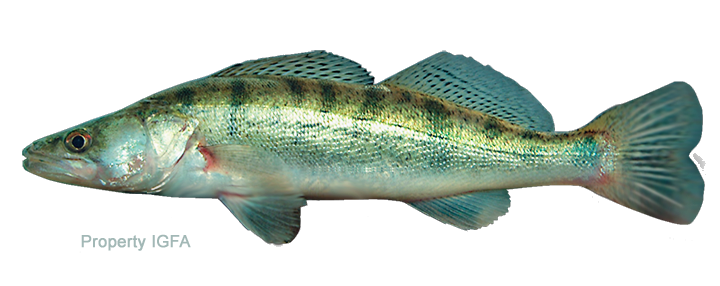Game Fish Identification Reference Guides
Walleye
(Sander vitreus)
(Sander vitreus)

(Mitchell, 1818); PERCIDAE FAMILY; also called yellow walleye, pike perch, walleyed pike perch, walleyed pickerel, yellow pickerel, yellow pike, yellow pike perch, walleye pike
This wide ranging North American species occurs from the Hudson Bay east to the St. Lawrence River, south to the Gulf coast of Alabama, and northwest of the Hudson Bay from Manitoba through the western Northwest Territories (including Great Slave and Great Bear Lakes) to the Beaufort Sea on the border of the Yukon Territory. In eastern drainages from Massachusetts southward it occurs all the way to the coast. It occurs from the Beaufort Sea south through Alberta, northeastern British Columbia and Montana to southern Arizona, the northern portions of Nevada and New Mexico, and then eastward to Georgia. Its western most limits are the states of Washington and Oregon where introduced populations occur.
The largest member of the perch family, it has been know to reach 25 lb (11 kg). Its closest relative and look a like is the sauger (Stizostedion canadense). Both have the large, glassy, opaque eyes that gave the walleye its name. In shallow water at night the eyes glow eerily under lights, readily identifying these fishes even before they can be seen. They sauger can be distinguished by the markings on their dorsal fins. The walleye's dorsal fin may be streaked, blotched, or plain, but lacks any clear spots and there is a prominent blotch at the posterior edge. On the sauger the fin is spotted and lacks any large blotch at the back edge. The lower lobe of the tail in the walleye is white tipped, a feature that is absent in the sauger. Internally, the walleye has 3 pyloric caeca each at least as long as the stomach, while the sauger has 3 9 (usually 5) pyloric caeca all considerably shorter than the stomach.
This is an extremely popular sport fish and an excellent food fish. The best fishing is at night when the walleye is feeding. The flesh is white to pink, firm and considered prime on the market
This wide ranging North American species occurs from the Hudson Bay east to the St. Lawrence River, south to the Gulf coast of Alabama, and northwest of the Hudson Bay from Manitoba through the western Northwest Territories (including Great Slave and Great Bear Lakes) to the Beaufort Sea on the border of the Yukon Territory. In eastern drainages from Massachusetts southward it occurs all the way to the coast. It occurs from the Beaufort Sea south through Alberta, northeastern British Columbia and Montana to southern Arizona, the northern portions of Nevada and New Mexico, and then eastward to Georgia. Its western most limits are the states of Washington and Oregon where introduced populations occur.
The largest member of the perch family, it has been know to reach 25 lb (11 kg). Its closest relative and look a like is the sauger (Stizostedion canadense). Both have the large, glassy, opaque eyes that gave the walleye its name. In shallow water at night the eyes glow eerily under lights, readily identifying these fishes even before they can be seen. They sauger can be distinguished by the markings on their dorsal fins. The walleye's dorsal fin may be streaked, blotched, or plain, but lacks any clear spots and there is a prominent blotch at the posterior edge. On the sauger the fin is spotted and lacks any large blotch at the back edge. The lower lobe of the tail in the walleye is white tipped, a feature that is absent in the sauger. Internally, the walleye has 3 pyloric caeca each at least as long as the stomach, while the sauger has 3 9 (usually 5) pyloric caeca all considerably shorter than the stomach.
This is an extremely popular sport fish and an excellent food fish. The best fishing is at night when the walleye is feeding. The flesh is white to pink, firm and considered prime on the market













